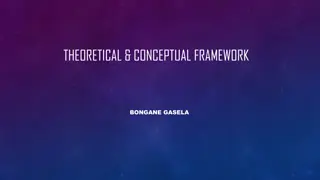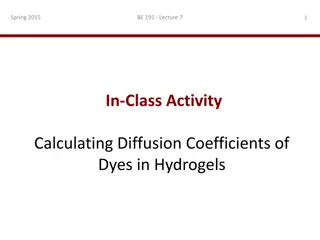Understanding Theoretical Concepts of Innovation and Diffusion Theories
Explore the theoretical concepts of innovation, comparing innovation vs. innovativeness and delving into the diffusion of innovation theory by Rogers. Discover how innovation, innovativeness, and the diffusion of innovation theory play crucial roles in organizational settings, impacting technology adoption and organizational structure.
Download Presentation

Please find below an Image/Link to download the presentation.
The content on the website is provided AS IS for your information and personal use only. It may not be sold, licensed, or shared on other websites without obtaining consent from the author. Download presentation by click this link. If you encounter any issues during the download, it is possible that the publisher has removed the file from their server.
E N D
Presentation Transcript
THEORETICAL CONCEPTS OF INNOVATION Tryapkin Nikita Sergeevich ntryapkin@hse.ru Saint-Petersburg, 2022
INNOVATION VS INNOVATIVENESS Can we say that terms innovation and innovativeness are interchangeable?
INNOVATION VS INNOVATIVENESS (KUNZ, SCHMITT & MEYER, 2011) Can we say that the terms innovation and innovativeness are interchangeable? Innovation focuses on the outcome of firm activity (i.e., goods and services) Innovativeness refers to the capability of a firm to be open to new ideas and work on new solutions
DIFFUSION OF INNOVATION THEORY (ROGERS, 1995) This theory of how, why, and at what rate new ideas and technology spread through cultures, operating to the individual and firm level; According to this theory, it is implied that people adopt innovations to varying degrees. Consequently, from a historical perspective, it has been observed that the number of populations adopting innovations is approximately normally distributed over time; Since the theory reflects a certain scale of innovativeness, we can segment the population into 5 groups in relation to innovations: innovators, early adopters, early majority, late majority, laggards. BUT: At the organizational level, the process of innovation is much more complex, as there are many individuals with their own roles.
DIFFUSION OF INNOVATION THEORY (ROGERS, 1995) Centralization - the degree to which power and control in a system are concentrated in the hands of a relatively few individuals; Complexity - the degree to which an organization s members possess a relatively high level of knowledge and expertise Formalization - the degree to which an organization emphasizes its members following rules and procedures Interconnectedness - the degree to which the units in a social system are linked by interpersonal networks Organizational slack - the degree to which uncommitted resources are available to an organization Size - the number of employees of the organization
TECHNOLOGY, ORGANIZATION, ENVIRONMENT (TORNATZKY & FLEISCHER, 1990) This framework was developed in 1990 The theory implies that there are three aspects that affect the enterprise. More precisely, these aspects affect the process of introducing innovations. This framework includes: 1. Technological context describes both the internal and external technologies relevant to the firm; 2. Organizational context refers to descriptive measures about the organization such as scope, size, and managerial structure; 3. Environmental context is the arena in which a firm conducts its business its industry, competitors, and dealings with the government. Definitions taken from paper Oliveira & Martins (2010:314)
TECHNOLOGY, ORGANIZATION, ENVIRONMENT (TORNATZKY & FLEISCHER, 1990)
FROM FIRM-CENTRIC VIEW OF INNOVATION TO CONSUMER-CENTRIC VIEW OF INNOVATION
TECHNOLOGY ACCEPTANCE MODEL (DAVIS,1989) This model based on several theories: self-efficacy theory, cost-benefit paradigm and adoption of innovation What is the reason for the acceptance and rejection of information technology? Perceived usefulness is defined here as the degree to which a person believes that using a particular system would enhance his or her job performance ; Perceived ease of use refers to "the degree to which a person believes that using a particular system would be free of effort .
TECHNOLOGY ACCEPTANCE MODEL (DAVIS,1989) Perceived usefulness Behavioral intention Actual system use Perceived ease of use
TECHNOLOGY ACCEPTANCE MODEL (VENKATESH & DAVIS,1996) External variables included some system characteristics, user training, user participation in design, and the nature of implementation process (Chuttur, 2009:10)
TECHNOLOGY ACCEPTANCE MODEL (VENKATESH & DAVIS,2000)
TECHNOLOGY ACCEPTANCE MODEL (VENKATESH, 2000) Anchors general beliefs about computers and (Chuttur, 2009:15); computer usage Adjustments beliefs that are shaped based on direct experience with the target system (Chuttur, 2009:15).
INNOVATION RESISTANCE THEORY (RAM & SHETH, 1989) Prerequisites: 1. Innovations can significantly change the daily lives of consumers and disrupt their established routines; 2. Consumer beliefs may not match new practices that emerge from the implementation of innovations. As a consequence, Innovation resistance is the resistance offered by consumers to an innovation, either because it poses potential changes from a satisfactory status quo or because it conflicts with their belief structure.
INNOVATION RESISTANCE THEORY (RAM & SHETH, 1989) There are a number of barriers that reduce the desire of consumers to adopt innovations. In general, we can divide them into two large groups: 1. The functional barriers: Usage Barrier some obstacles caused by likely changes, especially in the context of using new innovations compared to the existing system; Value barriers some inconsistency with the existing value system, specifically in the context of balancing between the cost of using the innovation and learning it in contrast with the offered benefits; Risk barriers some resistance resulting from uncertainties that are strongly connected with innovation. 2. Psychological barriers: Tradition Barrier a resistance associated with cultural change caused by innovation; Image Barrier - a type of resistance closely associated with negative impressions of the use or origin of the innovation. Some definitions taken from the paper by Kaur, Dhir, Singh, Sahu & Almotairi (2020: 5-6)
APPLICATION OF THE INNOVATION RESISTANCE THEORY (KAUR, DHIR, SINGH, SAHU & ALMOTAIRI, 2020)
PERCEIVED FIRM INNOVATIVENESS (KUNZ, SCHMITT & MEYER, 2011) Perceived firm innovativeness (PFI) is not a theory per se, but rather a concept. The authors implied that the implementation of innovations does not make a firm innovative. From a consumer- centric perspective, innovativeness includes all the actions of a company that significantly distinguish its uniqueness from competitors and make it significant in the eyes of the consumer. As a consequence, this leads to consumer incentives in order to purchase the unique product or service of this company. Finally, consumers are more likely to view a firm as innovative if it new and creative efforts have an impact on the market. PFI is the consumer's perception of an enduring firm capability that results in novel, creative, and impactful ideas and solutions for the market.























